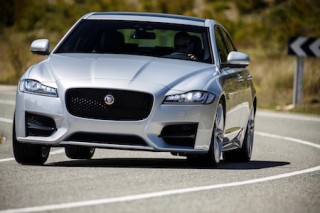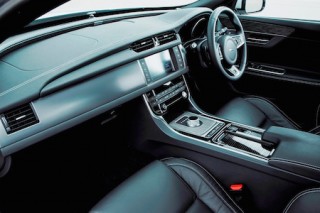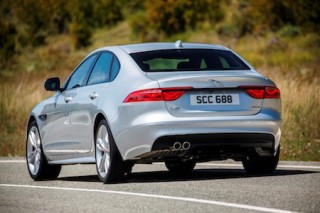 In the competitive automotive world time doesn’t stand still and an all-new Jaguar XF saloon 14-model range is with us with prices ranging from £32,300 to £49,945.
In the competitive automotive world time doesn’t stand still and an all-new Jaguar XF saloon 14-model range is with us with prices ranging from £32,300 to £49,945.
Jaguar claims the new XF’s running costs are lower, residual values higher and insurance costs also lower than the saloon versions it replaces and its major German premium brand competitor models.
The engine line-up is 2.0-litre four cylinder Ingenium turbodiesels with 163 and 180hp power outputs both with manual and automatic transmissions, an automatic 3.0-litre, 300hp V6 turbodiesel and a 3.0-litre, 380hp V6 supercharged petrol – again with an eight-speed automatic gearbox. For the UK market the 2.0-litre diesel models are available with Prestige, R-Sport and Portfolio specification choices whilst the 3.0-litre diesel and petrol versions are S specification.
The first official global media test driving of the new Jaguar XF rear wheel drive executive saloon took place last week at Pamplona in the foothills of the Pyrenees and the F1, MotoGP and Superbike licensed Circuito de Navarra Spain. From the line-up of models priced from £32,300 we had the opportunity to drive on challenging mountainous roads the best selling all-aluminium 2.0-litre 180hp Ingenium turbodiesel and the 3.0-litre V6 300hp turbodiesel. Models with the 3.0-litre, V6 supercharged 380hp petrol engine were put through their paces at the impressive race circuit.
Whilst the higher performance V6 supercharged petrol unit was interesting to sample on the race circuit to explore the outright handling capabilities of the new XF saloon, the core model of most importance was the XF with be the 2.0-litre, 180hp Ingenium turbodiesel. This new in-house Jaguar Land Rover variable valve timing turbodiesel unit, and the 163hp version, are claimed to be 24% more fuel and CO2 efficient than the previous Ford supplied 163 and 200hp 2.2-litre engines used in the outgoing XF.
The 180hp unit develops 430Nm of torque from 1,750rpm and is available with either a new six-speed manual gearbox or an eight-speed automatic which was fitted to the test cars as it will be the most popular choice for UK customers. Top speed is 136mph with zero to 62mph taking 8.1-seconds. Fuel consumption in the Combined Cycle is officially 65.7mpg with CO2 emissions of 114g/km so VED road tax is £0 for the First Year rate and then £30 for Year Two onwards. Company car drivers will pay just 20% in Benefit-in-Kind tax. Our test model had R-Sport specification and with the auto gearbox it costs £36,850 but if a manual model is more suitable – the price is £35,100.
The 180bhp power output, also used in the new Jaguar XE compact saloon, gives a very respectable top speed of 136mph but as with the XE it is the torque of 430Nm (317lb ft) from 1,750rpm that gives it the real shove for acceleration.
 The new Ingenium engine has a growl to it but it is not intrusive and once in ‘the cruise’ engine noise becomes more hushed but road noise intrusion becomes evident. Again as with the smaller Jaguar XE saloon it seems to be the case that aluminium body structures do transmit slightly more decibels and resonance than steel ones. With the eight-speed auto gearbox the engine is always in its sweet-spot for instant power delivery so mid range acceleration is immediate which is very good for overtaking slower traffic.
The new Ingenium engine has a growl to it but it is not intrusive and once in ‘the cruise’ engine noise becomes more hushed but road noise intrusion becomes evident. Again as with the smaller Jaguar XE saloon it seems to be the case that aluminium body structures do transmit slightly more decibels and resonance than steel ones. With the eight-speed auto gearbox the engine is always in its sweet-spot for instant power delivery so mid range acceleration is immediate which is very good for overtaking slower traffic.
In slower driving conditions around town the engine is quiet and very flexible. Our fuel economy driving some challenging but relatively traffic-free Spanish roads was 38.3mpg, not very close to the official 65.7mpg Combined Cycle but I would expect longer runs on motorways to see this figure improve to closer to the 50mpg mark. Insurance for this model is Group 27E.
When it came to the 3.0-litre, V6, 300hp turbodiesel with its huge torque output of 700Nm (516lb ft) from 2,000rpm this engine is only available with the eight-speed automatic transmission but why would you want anything else? It is hugely responsive and made very light work of the severe mountain climbs into the Pyrenees using very narrow winding roads. For the record top speed is 155mph and zero to 62mph takes 6.2-seconds. Officially the Combined Cycle figure is 51.4mpg – our test drive returned 37.8mpg, well below the official figure but only a shade worse than the 2.0-litre Ingenium engine and the test driving was done on a more challenging route. The big V6’s 144g/km of CO2 are not that off-putting either with road tax charges of £145 a year but business users will pay 26% Benefit-in-Kind tax. For those owners/drivers that cover long journeys who want effortless cruising performance this engine meets those needs very easily but the £10k price hike over the top spec 2.0-litre, 180hp turbodiesel will be financially off-putting. Insurance is Group 42E.
Moving swiftly on to the 3.0-litre V6 supercharged petrol 380hp engine this has 450Nm (332lb ft) of torque at 4,500rpm and is mated with the eight-speed automatic gearbox. Top speed is restricted to 155mph and zero to 62mph takes 5.3-seconds. The official fuel economy is 34mpg and no figure was taken on our circuit testing.
 The CO2 emissions are a relatively high 198g/km so road tax is £490 for the First Year rate reducing to £265 thereafter. Company car executives will pay 34% Benefit-in-Kind tax. In its latest Euro6 form Jaguar says this unit shows a 14% improvement in fuel economy and CO2 emissions over the previous version. Yes this engine for high performance petrol engine enthusiasts will appeal, it’s fast, it’s gutsy, it thrives on engine-revs and sounds great. Costing close to £50k it doesn’t sound so sweet though. Insurance is rated as Group 38E.
The CO2 emissions are a relatively high 198g/km so road tax is £490 for the First Year rate reducing to £265 thereafter. Company car executives will pay 34% Benefit-in-Kind tax. In its latest Euro6 form Jaguar says this unit shows a 14% improvement in fuel economy and CO2 emissions over the previous version. Yes this engine for high performance petrol engine enthusiasts will appeal, it’s fast, it’s gutsy, it thrives on engine-revs and sounds great. Costing close to £50k it doesn’t sound so sweet though. Insurance is rated as Group 38E.
In terms of ride comfort and handling the XF offers fast and precise change of direction handling for such a large car. The steering is well weighted with good feedback to the driver. The ride is generally on the comfortable side but ripples in the tarmac and potholes can unsettle the overall calmness the XF offers and it was much the same with the smaller XE.
In most ways the new XF is a larger cloned version of the slightly smaller and less expensive XE. It will be important for both model ranges to attract conquest customers to the Jaguar brand rather than the XE and XF to take customers from each other with few incremental sales. The German brands manage it – so should Jaguar.
MILESTONES:
Jaguar XF 2.0d 180hp R-Sport automatic 4-door executive saloon, (likely best selling version) £36,850.
Engine/transmission: Ingenium, 2.0-litre, 4-cylinder 180hp turbodiesel with 430Nm of torque from 1,750rpm, 8-speed auto.
Performance: 136mph, 0-62mph 8.1-seconds, Combined Cycle 65.7mpg (38.3mpg on test),
CO2 114g/km, VED road tax £0/£30, BIK company car tax 20%.
Insurance group: 27E Warranty: 3-years/unlimited mileage.
Dimensions/capacities: L 4,954mm, W 1,880mm, H 1,457mm, boot 540-litres.
For: Strong and responsive new Jaguar engine, CO2 efficient so its tax friendly, agile, executive class ride comfort, high specification, more spacious interior, great visual kerb-appeal.
Against: The Spartan design of the fascia will not appeal to all potential customers as it looks less executive class and more business-user class, some road noise intrusion, the slightly smaller new XE looks very similar – it has the same 2.0-litre diesel engine options and it’s cheaper to buy/lease.
